Integrated All-Climate Heating/Cooling System Design and Preheating Strategy for Lithium-Ion Battery Pack
Abstract
1. Introduction
2. Construction and Verification of Thermal Model of Battery Pack
2.1. Experimental Platform Construction and Battery Performance Parameter Testing
2.2. Construction of Thermal Model of Lithium-Ion Battery
2.2.1. Lithium-Ion Battery Heat Generation Model
2.2.2. Lithium-Ion Battery Heat Transfer Model
2.3. Model Validation
- (1)
- Determine the position of the thermocouple, arrange the thermocouple in the corresponding position, wrap it with thermal insulation cotton, and connect the thermocouple to the data collector;
- (2)
- Connect the battery to the charger/discharge machine, set the temperature of the incubator to 25 °C, and place the battery with the thermocouple arranged in the incubator for 3 h;
- (3)
- Use the host computer to write a program to set the experimental steps, so that the battery is charged with constant current from the lower cut-off voltage (2 V) to the upper cut-off voltage (3.65 V) at 1C and 2C rates, respectively, and the temperature data at each temperature point are recorded;
- (4)
- Based on the heat generation and heat transfer model of the battery, a three-dimensional heat generation model of the battery cell is established through finite element analysis software, and the battery parameters and boundary conditions are input to simulate and record the temperature change during the battery charging process.
3. Design and Optimization of External Thermal Management System
3.1. Design of Cooling/Preheating Structure of Li-Ion Battery Pack
3.2. Parameter Optimization and External Preheating Scheme Analysis Method
3.3. Optimization of Preheating Parameters on Three Sides of Power Battery Pack
3.3.1. Analysis of the Influence of Flow Velocity
3.3.2. Analysis of the Influence of Inlet Temperature
3.4. Structural Optimization and Analysis of External Preheating Scheme
3.4.1. Analysis of Adding a Cooling Plate and the Influence on Preheating Effect
3.4.2. Parameter Selection of Preheating Structure after Optimization
4. Combined Internal and External Battery Pack Preheating Strategy
4.1. Establishment and Effect Analysis of Combined Preheating System Inside and Outside the Battery Pack
4.2. Orthogonal Simulation Scheme Formulation and Analysis
4.3. Internal and External Joint Preheating Strategy Based on Available Capacity of Battery
- When the state-of-charge of the battery is lower than 20%, the battery is preheated by external preheating, the three-sided cooling plate structure is adopted, and the coolant flow rate is selected as 1 m/s. To reduce the temperature difference of the module after preheating, the inlet temperature of the coolant is 20 °C;
- When the state of charge of the battery is 30%, the external preheating method is used to preheat the battery first. A coolant inlet temperature of 35 °C is selected as the upper limit, and a flow rate of 1 m/s to shorten the time of external preheating. When the minimum temperature of the battery reaches −10 °C, the available capacity of the battery increases, the internal and external preheating method is then adopted, the discharge current is 3 A, and the inlet temperature is switched to 25 °C to reduce the temperature difference of the module after preheating and to shorten the preheating time;
- When the state of charge of the battery is 40–50%, it meets the requirements of continuous DC discharge during the preheating time. Therefore, the combined internal and external preheating method is adopted, the discharge current is 3 A, the inlet temperature is 25 °C, and the flow rate is 1 m/s;
- When the state of charge of the battery is above 60%, the usable capacity of the battery is relatively large. The internal and external preheating method is adopted, and the discharge current is 6 A to shorten the preheating time. The coolant inlet temperature is selected as 25 °C, and the flow rate is 1 m/s.
5. Conclusions
- In the external preheating method, the cooling plate arrangement scheme and the inlet temperature have an obvious influence on the preheating effect, while the improvement in the flow velocity on the preheating effect is saturated;
- To solve the issue regarding the uneven distribution of external preheating, an optimized external battery pack preheating structure is established that can significantly improve the preheating effect. Compared with three-sided preheating, the temperature difference of the module at the same flow rate and the same inlet temperature is reduced by an average of 0.75 °C and 0.5 °C, respectively;
- Aimed at a long external preheating time, a combined internal and external preheating method based on DC discharge and external preheating is proposed according to the currently available battery power. The results show that, compared with external preheating, the preheating time of this preheating method is reduced by approximately 50%, which can effectively improve the issue regarding the battery’s long external preheating time.
Author Contributions
Funding
Data Availability Statement
Conflicts of Interest
References
- Hao, X.; Yuan, Y.; Wang, H.; Ouyang, M. Plug-in hybrid electric vehicle utility factor in China cities: Influencing factors, empirical research, and energy and environmental application. eTransportation 2021, 10, 100138. [Google Scholar] [CrossRef]
- Liu, J.; Wang, Z.; Hou, Y.; Qu, C.; Hong, J.; Lin, N. Data-driven energy management and velocity prediction for four-wheel-independent-driving electric vehicles. eTransportation 2021, 9, 100119. [Google Scholar] [CrossRef]
- Leng, F.; Tan, C.M.; Pecht, M. Effect of Temperature on the Aging rate of Li Ion Battery Operating above Room Temperature. Sci. Rep. 2015, 5, 12967. [Google Scholar] [CrossRef] [PubMed]
- Yang, X.; Doyle-Davis, K.; Gao, X.; Sun, X. Recent progress and perspectives on designing high-performance thick electrodes for all-solid-state lithium batteries. eTransportation 2021, 11, 100152. [Google Scholar] [CrossRef]
- Waag, W.; Kabitz, S.; Sauer, D. Experimental investigation of the lithium-ion battery impedance characteristic at various conditions and aging states and its influence on the application. Appl. Energy 2013, 102, 885–897. [Google Scholar] [CrossRef]
- Zheng, F.; Jiang, J.; Sun, B.; Zhang, W.; Pecht, M. Temperature dependent power capability estimation of lithium-ion batteries for hybrid electric vehicles. Energy 2016, 113, 64–75. [Google Scholar] [CrossRef]
- Liao, C. Electrolytes and additives for batteries Part I: Fundamentals and insights on cathode degradation mechanisms. eTransportation 2020, 5, 100068. [Google Scholar] [CrossRef]
- Wang, Y.; Zhang, X.; Chen, Z. Low temperature preheating techniques for Lithium-ion batteries: Recent advances and future challenges. Appl. Energy 2022, 313, 118832. [Google Scholar] [CrossRef]
- Hu, G.; Huang, P.; Bai, Z.; Wang, Q.; Qi, K. Comprehensively analysis the failure evolution and safety evaluation of automotive lithium-ion battery. eTransportation 2021, 10, 100140. [Google Scholar] [CrossRef]
- Petzl, M.; Kasper, M.; Danzer, M.A. Lithium plating in a commercial lithium-ion battery-A low-temperature aging study. J. Power Sources 2015, 275, 799–807. [Google Scholar] [CrossRef]
- Hales, A.; Prosser, R.; Diaz, L.B.; White, G.; Patel, Y.; Offer, G. The Cell Cooling Coefficient as a design tool to optimise thermal management of lithium-ion cells in battery packs. eTransportation 2021, 6, 100089. [Google Scholar] [CrossRef]
- Qin, P.; Sun, J.; Yang, X.; Wang, Q. Battery thermal management system based on the forced-air convection: A review. eTransportation 2021, 7, 100097. [Google Scholar] [CrossRef]
- Stuart, T.A.; Hande, A. HEV battery heating using AC currents. J. Power Sources 2004, 129, 368–378. [Google Scholar] [CrossRef]
- Wu, S.; Xiong, R.; Li, H.; Nian, V.; Ma, S. The state of the art on preheating lithium-ion batteries in cold weather. J. Energy Storage 2020, 27, 101059. [Google Scholar] [CrossRef]
- Yue, Q.L.; He, C.X.; Wu, M.C.; Zhao, T.S. Advances in thermal management systems for next-generation power batteries. Int. J. Heat Mass Transf. 2021, 181, 121853. [Google Scholar] [CrossRef]
- Ji, Y.; Wang, C.Y. Heating strategies for Li-ion batteries operated from subzero temperatures. Electrochim. Acta 2013, 107, 113797. [Google Scholar] [CrossRef]
- Ruan, H.; Jiang, J.; Sun, B.; Su, X.; He, X.; Zhao, K. An optimal internal-heating strategy for lithium-ion batteries at low temperature considering both heating time and lifetime reduction. Appl. Energy 2019, 256, 1–11. [Google Scholar] [CrossRef]
- Ruan, H.; Sun, B.; Zhu, T.; He, X.; Su, X.; Cruden, A.; Gao, W. Compound self-heating strategies and multi-objective optimization for lithium-ion batteries at low temperature. Appl. Therm. Eng. 2021, 186, 116158. [Google Scholar] [CrossRef]
- Guo, S.; Yang, R.; Shen, W.; Liu, Y.; Guo, S. DC-AC hybrid rapid heating method for lithium-ion batteries at high state of charge operated from low temperatures. Energy 2022, 238, 121809. [Google Scholar] [CrossRef]
- Qu, Z.; Jiang, Z.; Wang, Q. Experimental study on pulse self-heating of lithium-ion battery at low temperature. Int. J. Heat Mass Transf. 2019, 135, 696–705. [Google Scholar] [CrossRef]
- Ghassemi, A.; Hollenkamp, A.F.; Banerjee, P.C.; Bahrani, B. Impact of high-amplitude alternating current on LiFePO4 battery life performance: Investigation of AC-preheating and microcycling effects. Appl. Energy 2022, 314, 118940. [Google Scholar] [CrossRef]
- Hu, X.; Zheng, Y.; Howey, D.A.; Perez, H.; Foley, A.; Pecht, M. Battery warm-up methodologies at subzero temperatures for automotive applications: Recent advances and perspectives. Prog. Energy Combust. Sci. 2020, 77, 100806. [Google Scholar] [CrossRef]
- Ruan, H.; Sun, B.; Cruden, A.; Zhu, T.; Jiang, J.; He, X.; Su, X.; Ghoniem, E. Optimal external heating resistance enabling rapid compound self-heating for lithium-ion batteries at low temperatures. Appl. Therm. Eng. 2022, 200, 117536. [Google Scholar] [CrossRef]
- Wang, Y.; Rao, Z.; Liu, S.; Li, X.; Li, H.; Xiong, R. Evaluating the performance of liquid immersing preheating system for Lithium-ion battery pack. Appl. Therm. Eng. 2021, 190, 116811. [Google Scholar] [CrossRef]
- Guo, J.; Jiang, F. A novel electric vehicle thermal management system based on cooling and heating of batteries by refrigerant. Energy Convers. Manag. 2021, 237, 114145. [Google Scholar] [CrossRef]
- Lin, C.; Wang, F.; Fan, B.; Ren, S.; Zhang, Y.; Han, L.; Liu, S.; Xu, S. Comparative study on the heat generation behavior of lithium-ion batteries with different cathode materials using accelerating rate calorimetry. Energy Procedia 2017, 142, 3369–3374. [Google Scholar] [CrossRef]
- Monika, K.; Chakraborty, C.; Roy, S.; Dinda, S.; Singh, S.A.; Datta, S.P. An improved mini-channel based liquid cooling strategy of prismatic LiFePO4 batteries for electric or hybrid vehicles. J. Energy Storage 2021, 35, 102301. [Google Scholar] [CrossRef]
- Liu, H.; Chika, E.; Zhao, J. Investigation into the effectiveness of nanofluids on the mini-channel thermal management for high power lithium-ion battery. Appl. Therm. Eng. 2018, 142, 511–523. [Google Scholar] [CrossRef]
- Chen, F.C.; Gao, Z.; Loutfy, R.O.; Hecht, M. Analysis of Optimal Heat Transfer in a PEM Fuel Cell Cooling Plate. Fuel Cells 2003, 3, 181–188. [Google Scholar] [CrossRef]
- Lyu, P.; Liu, X.; Qu, J.; Zhao, J.; Huo, Y.; Qu, Z.; Rao, Z. Recent advances of thermal safety of lithium-ion battery for energy storage. Energy Storage Mater. 2020, 31, 195–220. [Google Scholar] [CrossRef]
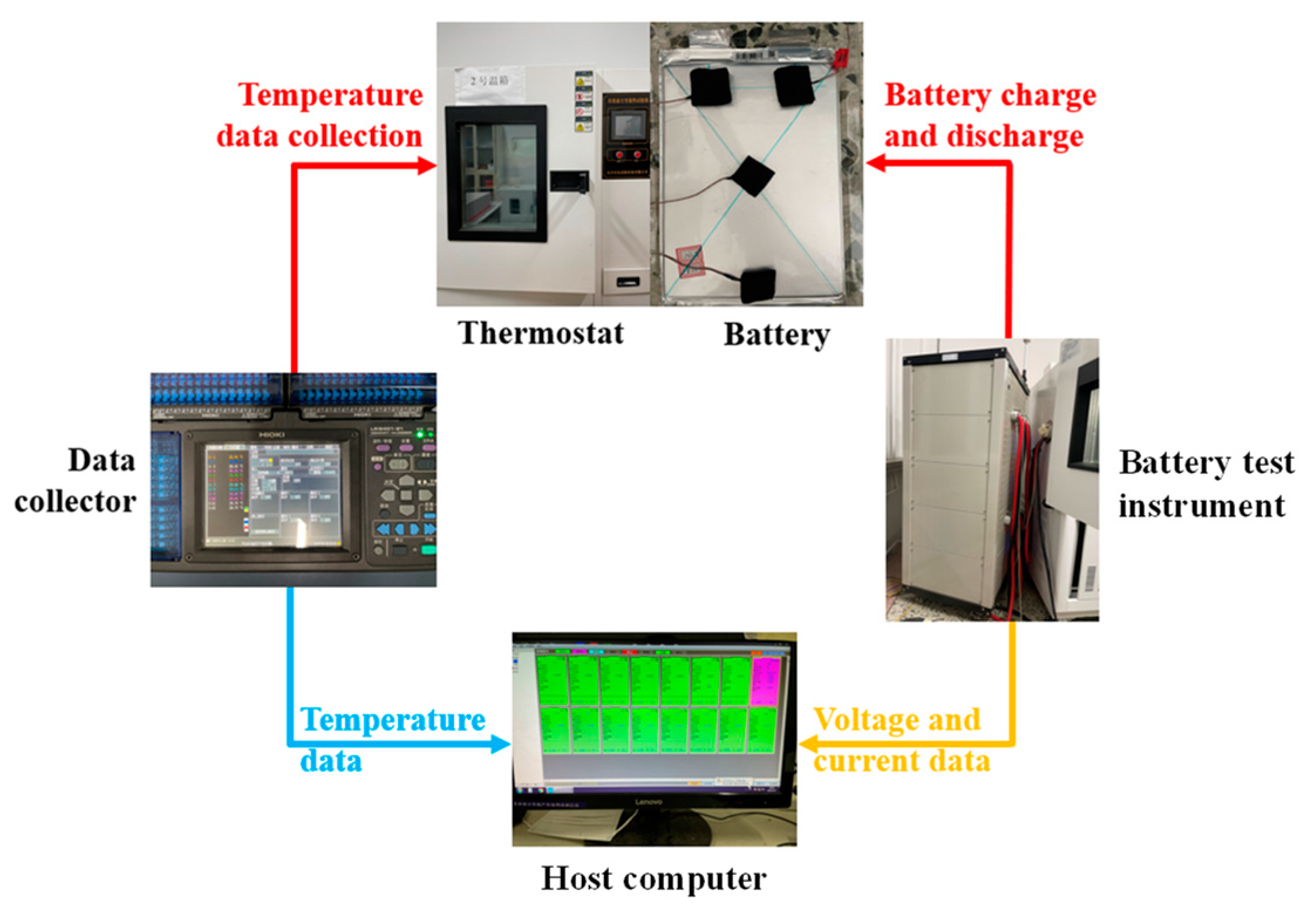
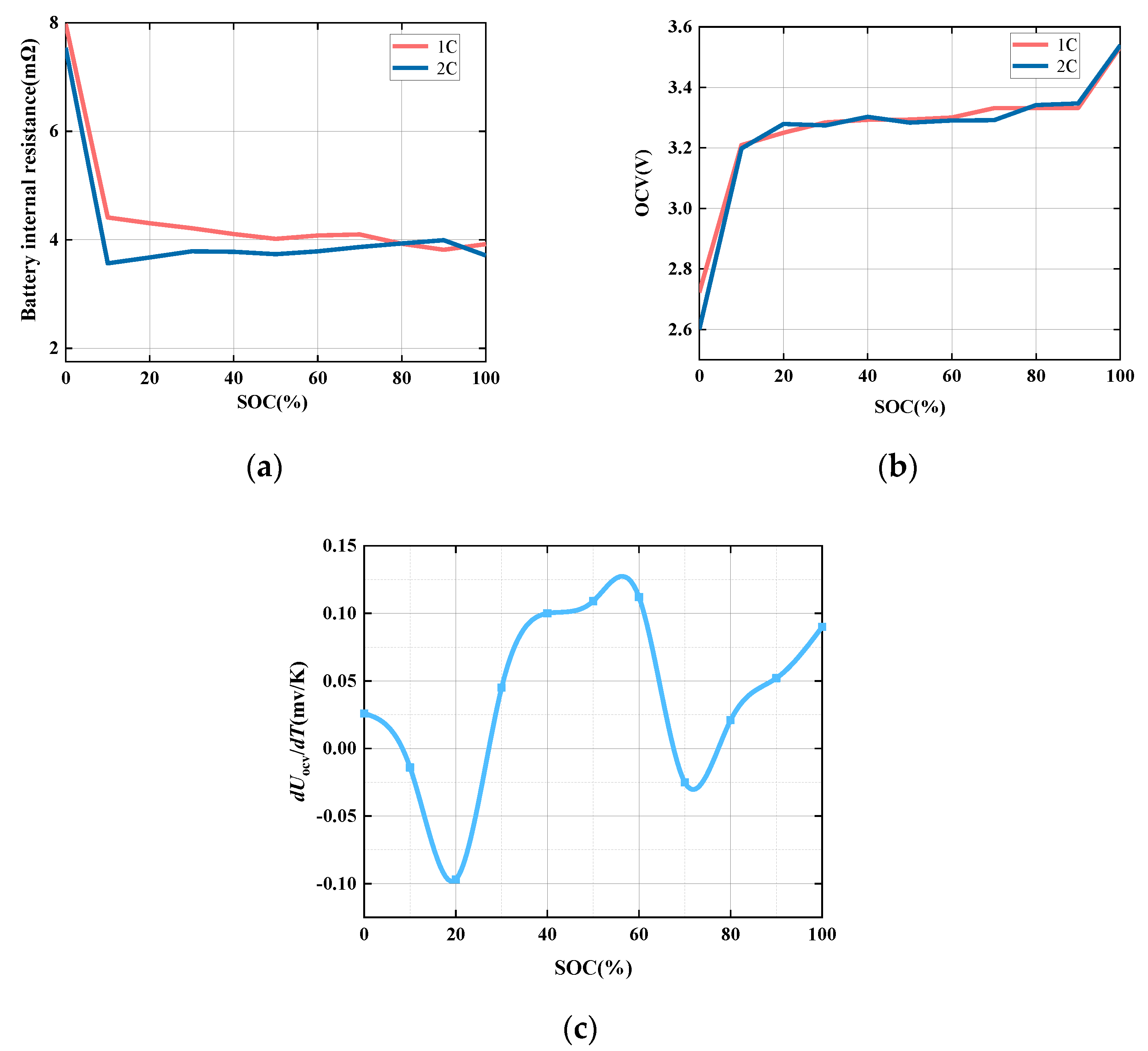
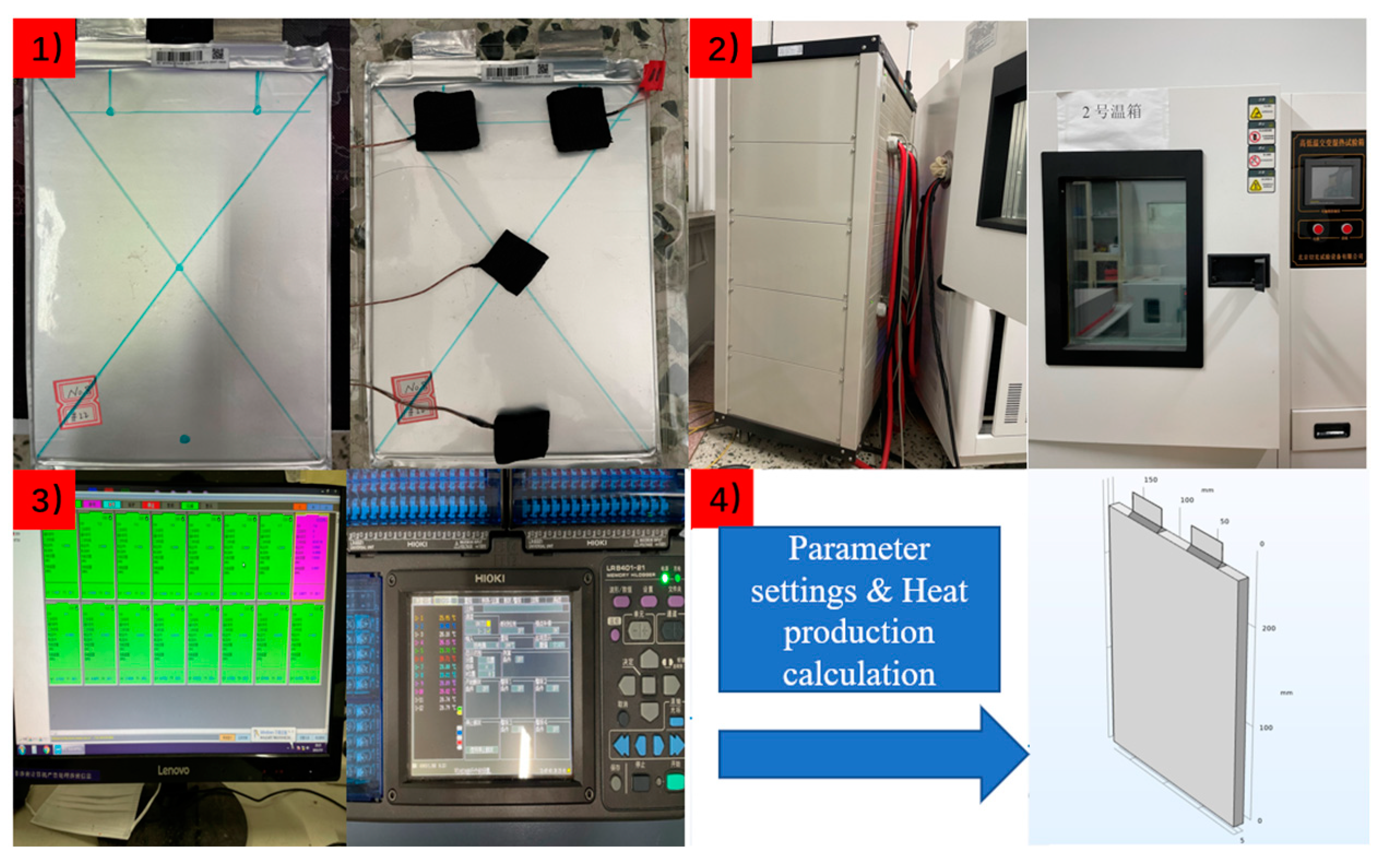
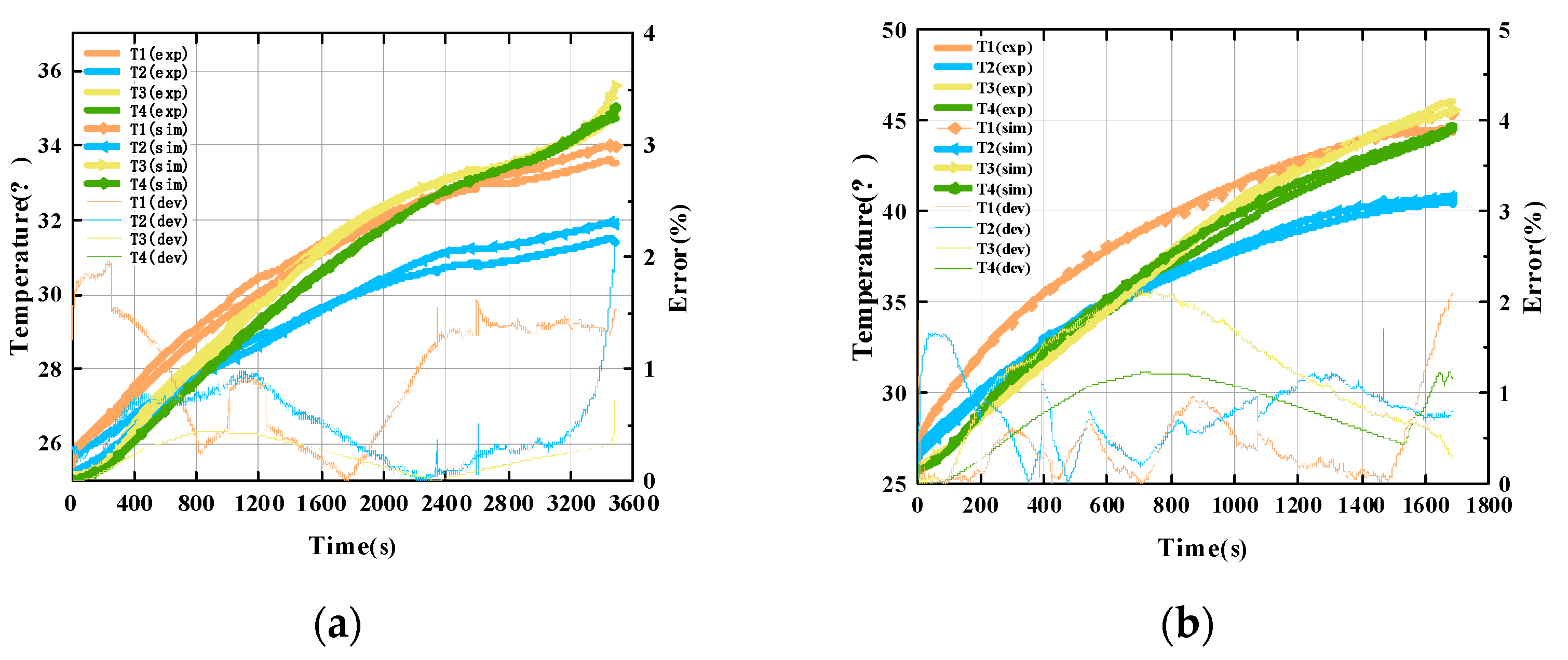


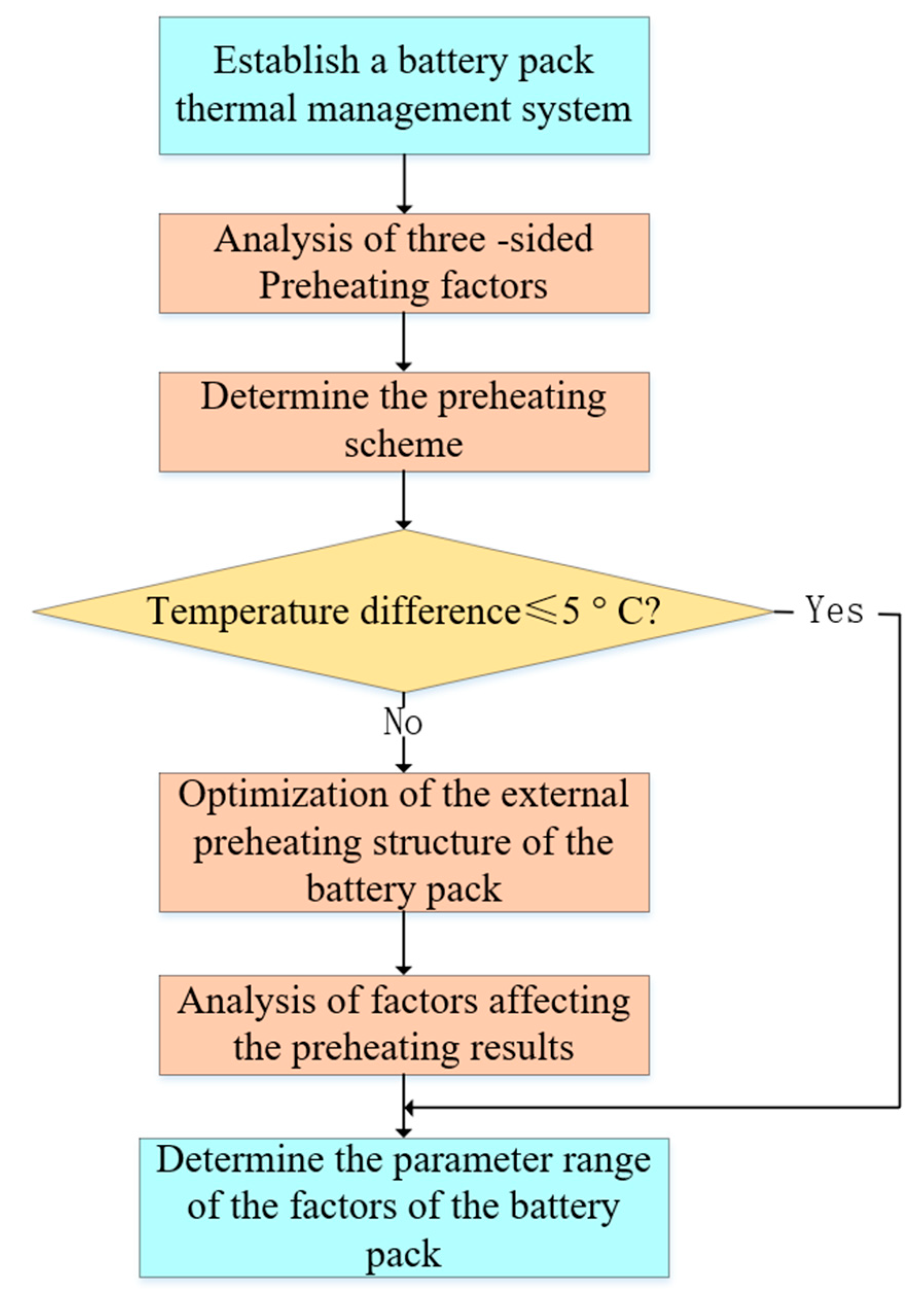
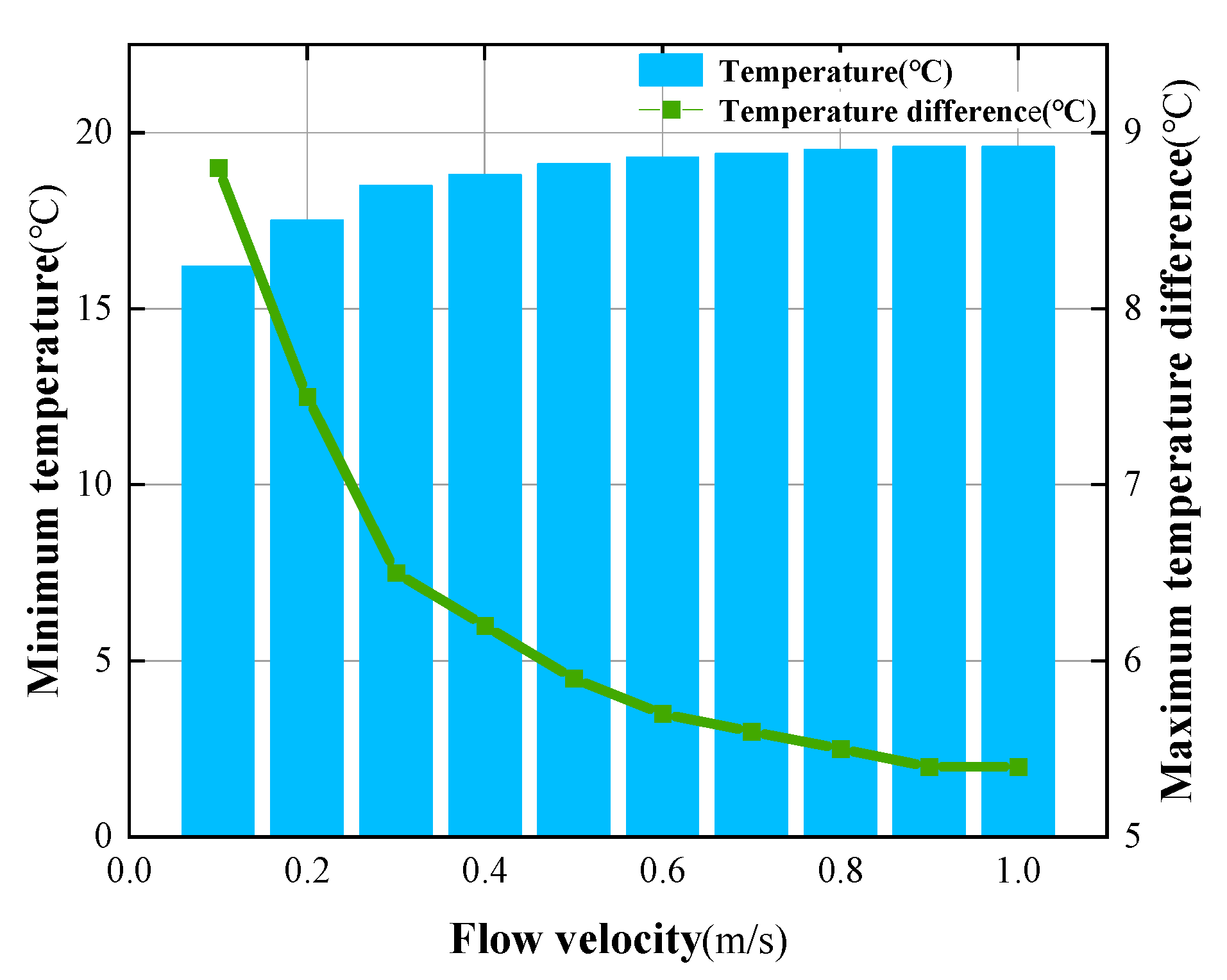

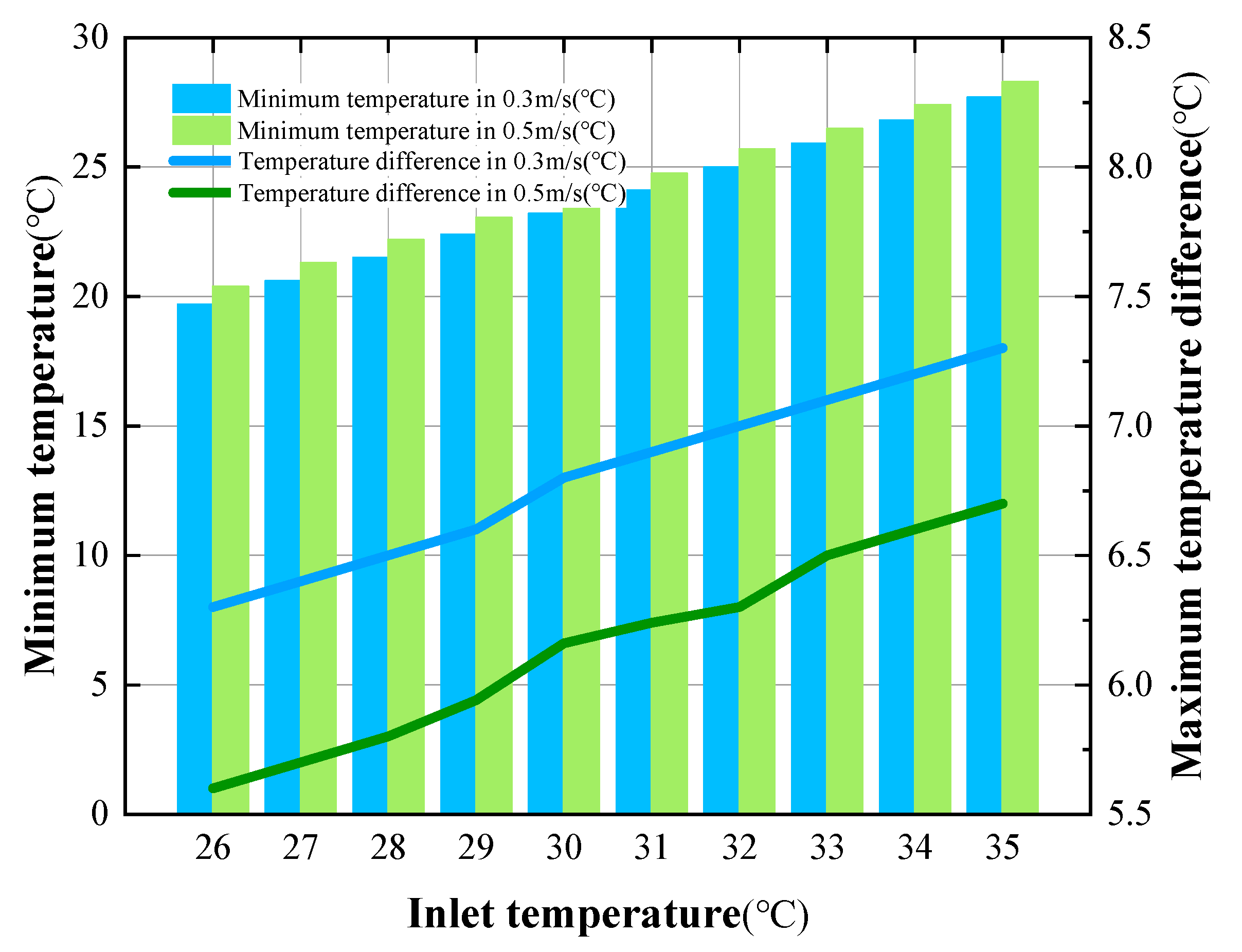
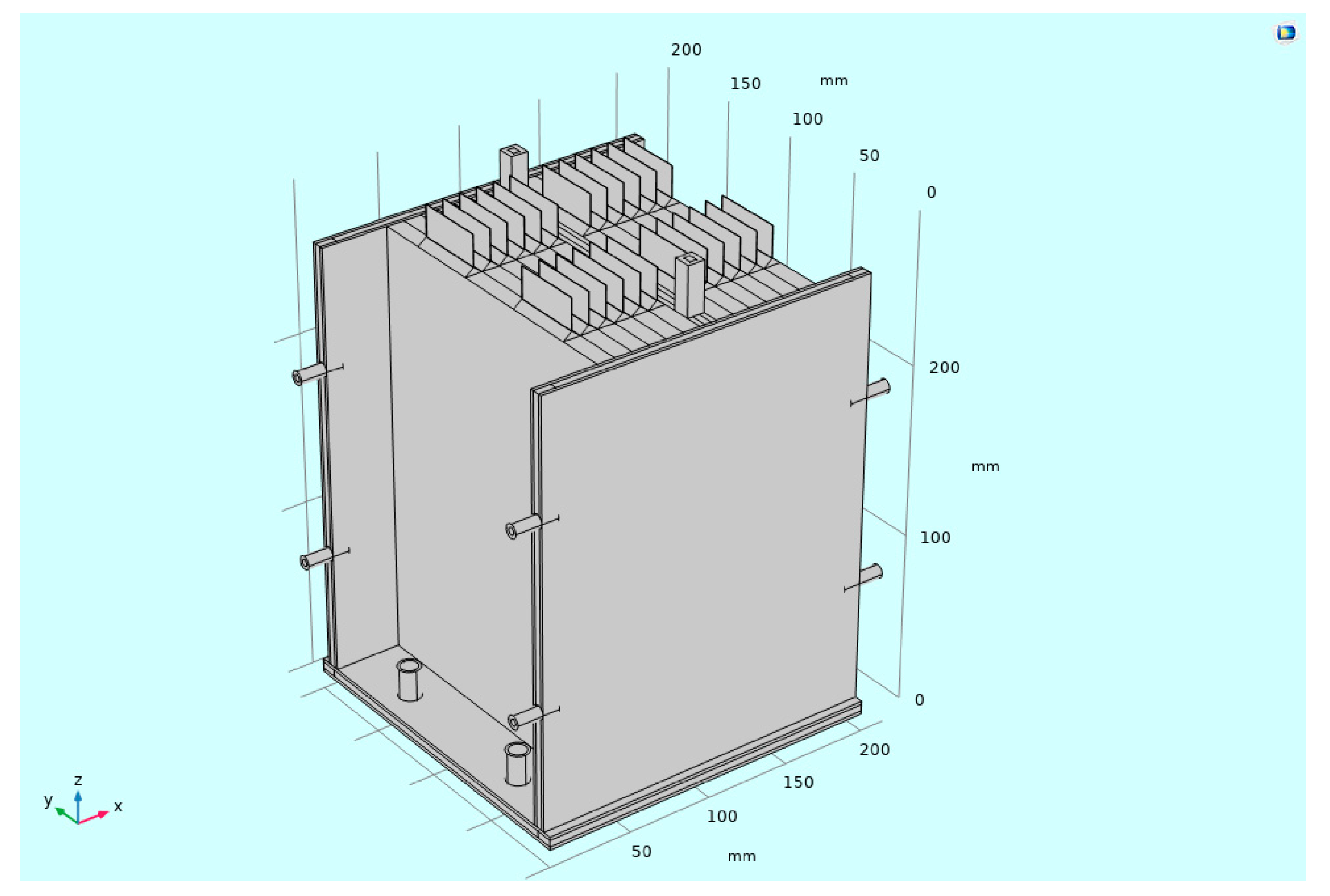
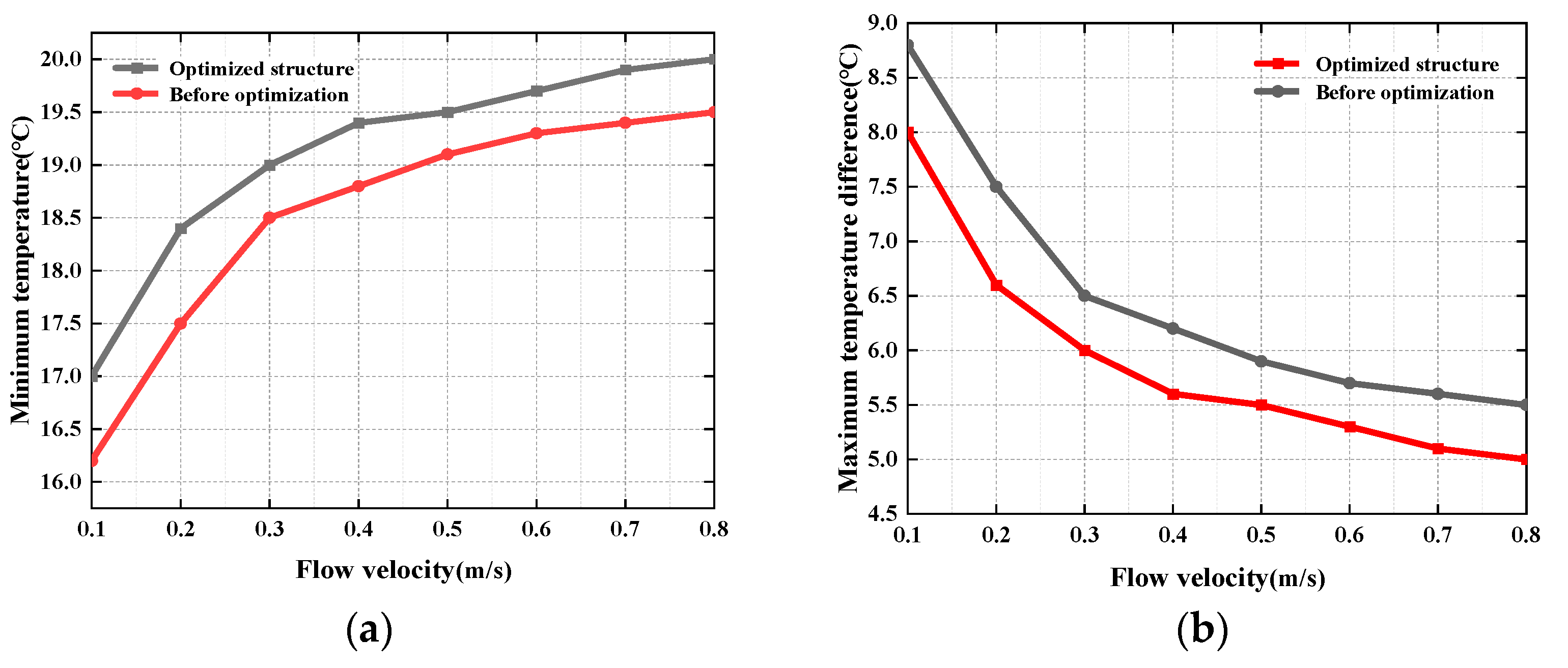

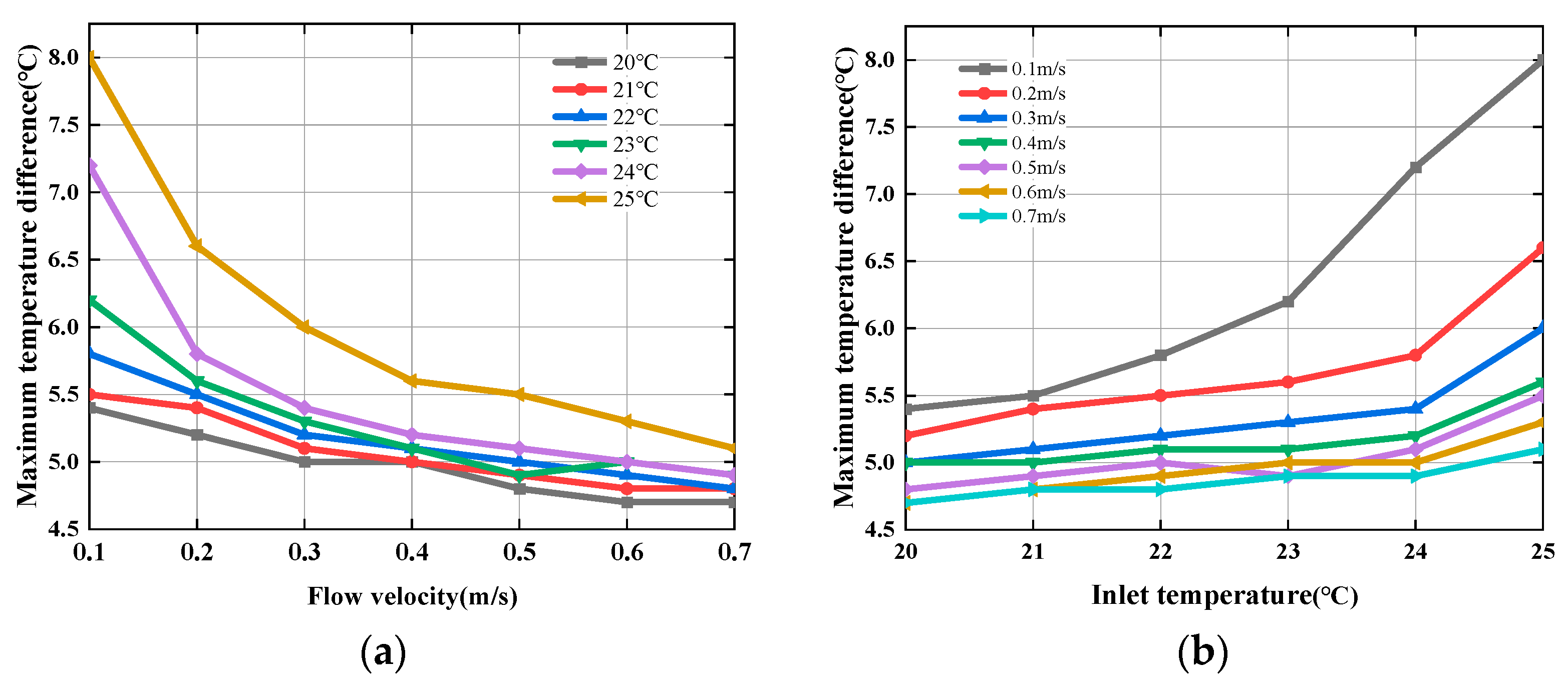

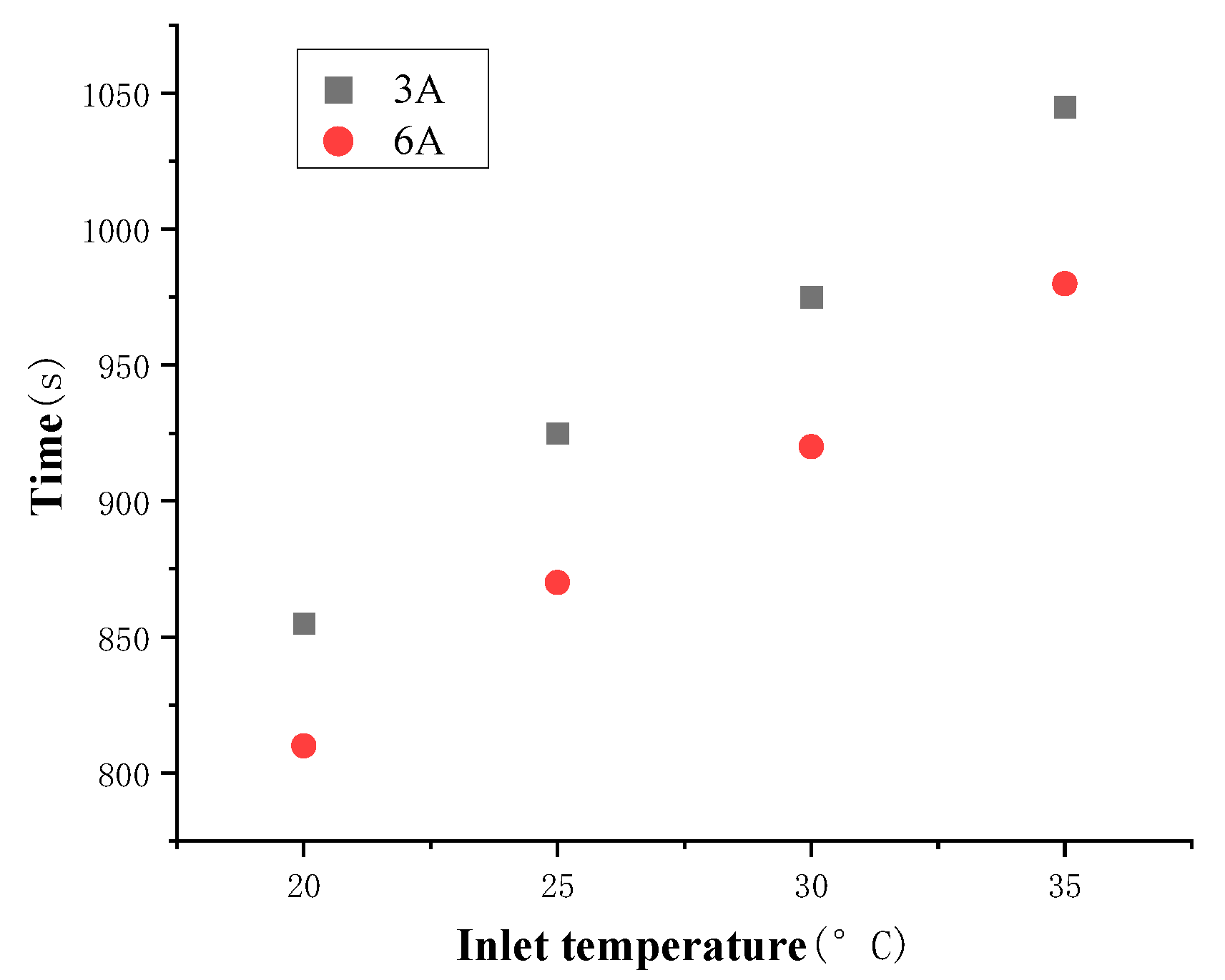


| Parameters/Units | Number |
|---|---|
| Weight/g | 795 ± 2 |
| Dimensions (L × W × H)/mm | 251 × 174 × 10.2 |
| Nominal capacity/Ah | 30 |
| Nominal voltage/V | 3.2 |
| Charge cut-off voltage/V | 3.65 |
| Discharge cut-off voltage/V | 2.0 |
| Charging working temperature/°C | 0~45 |
| Discharge working temperature/°C | −20~60 |
| Standard charge and discharge rate | 0.3 C |
| Material | Specific Heat Capacity (J/kg·K) | Density (kg/m³) | Thermal Conductivity (W/(m·K)) | Viscosity (Pa·s) |
|---|---|---|---|---|
| water | 4180 | 998.23 | 0.599 | 0.001001 |
| aluminum | 903 | 2707 | 237 | -- |
| Maximum Temperature (°C) | Minimum Temperature (°C) | Temperature Difference (°C) | Ambient Temperature (°C) | |
|---|---|---|---|---|
| 0.1 m/s | 25 | 16.2 | 8.8 | −20 |
| 0.2 m/s | 25 | 17.5 | 7.5 | −20 |
| 0.3 m/s | 25 | 18.5 | 6.5 | −20 |
| 0.4 m/s | 25 | 18.8 | 6.2 | −20 |
| 0.5 m/s | 25 | 19.1 | 5.9 | −20 |
| 0.6 m/s | 25 | 19.3 | 5.7 | −20 |
| 0.7 m/s | 25 | 19.4 | 5.6 | −20 |
| 0.8 m/s | 25 | 19.5 | 5.5 | −20 |
| 0.9 m/s | 25 | 19.6 | 5.4 | −20 |
| 1.0 m/s | 25 | 19.6 | 5.4 | −20 |
| 26 °C | 27 °C | 28 °C | 29 °C | 30 °C | 31 °C | 32 °C | 33 °C | 34 °C | 35 °C | |
|---|---|---|---|---|---|---|---|---|---|---|
| 0.3 m/s | 26/0.3 | 27/0.3 | 28/0.3 | 29/0.3 | 30/0.3 | 31/0.3 | 32/0.3 | 33/0.3 | 34/0.3 | 35/0.3 |
| 0.5 m/s | 26/0.5 | 27/0.5 | 28/0.5 | 29/0.5 | 30/0.5 | 31/0.5 | 32/0.5 | 33/0.5 | 34/0.5 | 35/0.5 |
| Flow Velocity/Inlet Temperature | 20 °C | 21 °C | 22 °C | 23 °C | 24 °C | 25 °C |
|---|---|---|---|---|---|---|
| 0.1 m/s | 0.1/20 | 0.1/21 | 0.1/22 | 0.1/23 | 0.1/24 | 0.1/25 |
| 0.2 m/s | 0.2/20 | 0.2/21 | 0.2/22 | 0.2/23 | 0.2/24 | 0.2/25 |
| 0.3 m/s | 0.3/20 | 0.3/21 | 0.3/22 | 0.3/23 | 0.3/24 | 0.3/25 |
| 0.4 m/s | 0.4/20 | 0.4/21 | 0.4/22 | 0.4/23 | 0.4/24 | 0.4/25 |
| 0.5 m/s | 0.5/20 | 0.5/21 | 0.5/22 | 0.5/23 | 0.5/24 | 0.5/25 |
| 0.6 m/s | 0.6/20 | 0.6/21 | 0.6/22 | 0.6/23 | 0.6/24 | 0.6/25 |
| 0.7 m/s | 0.7/20 | 0.7/21 | 0.7/22 | 0.7/23 | 0.7/24 | 0.7/25 |
| Flow Velocity/ Inlet Temperature | 20 °C | 21 °C | 22 °C | 23 °C | 24 °C | 25 °C |
|---|---|---|---|---|---|---|
| 0.1 m/s | 5.4 | 5.5 | 5.6 | 5.8 | 5.9 | 8 |
| 0.2 m/s | 5.2 | 5.4 | 5.4 | 5.5 | 5.5 | 6.6 |
| 0.3 m/s | 5 | 5.1 | 5.2 | 5.3 | 5.4 | 6 |
| 0.4 m/s | 5 | 5 | 5.1 | 5.1 | 5.2 | 5.6 |
| 0.5 m/s | 4.8 | 4.9 | 5 | 4.9 | 5.1 | 5.5 |
| 0.6 m/s | 4.7 | 4.8 | 4.9 | 5 | 5 | 5.3 |
| 0.7 m/s | 4.7 | 4.8 | 4.8 | 4.9 | 4.9 | 5.1 |
 : ≤ 5 °C;
: ≤ 5 °C;  : ≥ 5 °C.
: ≥ 5 °C.| Preheating Method | Parameter | Numerical Value |
|---|---|---|
| External preheating | Cooling plate arrangement | Three-sided cooling plate structure |
| Coolant flow rate | 1 m/s | |
| Coolant temperature | 25 °C | |
| Internal preheating | DC discharge | 3 A |
| Discharge Current/ Inlet Temperature | 20 °C | 25 °C | 30 °C | 35 °C |
|---|---|---|---|---|
| 3 A | 3/20 | 3/25 | 3/30 | 3/35 |
| 6 A | 6/20 | 6/25 | 6/30 | 6/35 |
| State of Charge | External Preheating Time (s) | Combined Internal and External Preheating Time (s) | Total Time (s) | Minimum Temperature after Preheating (°C) | Maximum Temperature Difference after Preheating (°C) |
|---|---|---|---|---|---|
| <20% | 1740 | -- | 1740 | 15 | 5 |
| 30% | 155 | 790 | 945 | 20 | 5 |
| 40–50% | -- | 925 | 925 | 20 | 5 |
| >60% | -- | 865 | 865 | 20 | 5 |
Publisher’s Note: MDPI stays neutral with regard to jurisdictional claims in published maps and institutional affiliations. |
© 2022 by the authors. Licensee MDPI, Basel, Switzerland. This article is an open access article distributed under the terms and conditions of the Creative Commons Attribution (CC BY) license (https://creativecommons.org/licenses/by/4.0/).
Share and Cite
Wu, X.; Wei, Z.; Sun, Y.; Sun, J.; Du, J. Integrated All-Climate Heating/Cooling System Design and Preheating Strategy for Lithium-Ion Battery Pack. Batteries 2022, 8, 179. https://doi.org/10.3390/batteries8100179
Wu X, Wei Z, Sun Y, Sun J, Du J. Integrated All-Climate Heating/Cooling System Design and Preheating Strategy for Lithium-Ion Battery Pack. Batteries. 2022; 8(10):179. https://doi.org/10.3390/batteries8100179
Chicago/Turabian StyleWu, Xiaogang, Zhixin Wei, Yizhao Sun, Jinlei Sun, and Jiuyu Du. 2022. "Integrated All-Climate Heating/Cooling System Design and Preheating Strategy for Lithium-Ion Battery Pack" Batteries 8, no. 10: 179. https://doi.org/10.3390/batteries8100179
APA StyleWu, X., Wei, Z., Sun, Y., Sun, J., & Du, J. (2022). Integrated All-Climate Heating/Cooling System Design and Preheating Strategy for Lithium-Ion Battery Pack. Batteries, 8(10), 179. https://doi.org/10.3390/batteries8100179









